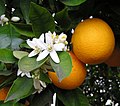Adventist Adventurer Awards and Answers/Friend of Nature
| Friend of Nature | |
|---|---|
| Sunbeam |
Take a nature walk and discover items of interest.
[edit | edit source]- Show or tell what you found.
- Make these items into a collage or poster.
List the names of three different trees and do a bark rubbing of each.
[edit | edit source]Teaching Idea: Bark Rubbing
Materials: pieces of copy paper, large “chunky” crayons, trees
Procedure: Take a few sheets of paper and y crayons (big chunky crayons work best) to the woods or your local park, and get creative. Encourage each child to choose an interesting tree – big, old, knobbly ones are perfect. They might need a grown-up or friend to help them keep the paper still while they make their rubbings, Find other trees and layer up different colours and patterns.
Note: A naturalist may help you with identification. MANY local parks (in USA and Canada) have paved or graveled trails set up with tree identification plaques and trail guides which would be very helpful for this activity.
-
WalnutTree
-
Pine Tree
-
Orange Tree
Collect four different kinds of leaves and compare.
[edit | edit source]Teaching Idea: Box Collection
Materials: Shoe box or other box with a lid for each child
Procedure: Go on a nature walk (great Family Networking event option!) and collect things to put in the box. Make observations as they are placed carefully in the box. Having someone along who know about nature is helpful! NOTE: As requirement one states, be sure you are walking in an area where collection is allowed. Some nature centers offer “touch boxes” for temporary use or on a guided trail. These would also fulfill the requirement yet be friendly to the environment.
-
Cilantro Leaves
-
Oak Leaves
-
Maple Leaf
-
Cedar Needles
Go on a critter hunt. Explore (or observe with a magnifying glass) all the things you can see in a 10 square foot area.
[edit | edit source]Critters are another name for animals of various kinds. in a 10 foot (3 meter) area, you are likely to discover a lot of bugs and worms. If the children are lucky a bird might cross above the group or a reptile might scurry by.
Find the area: wooded or edge of woods area work best. Be aware of plants that are poisonous to the touch (Poison Ivy, Oak in the USA for example) when setting up the 3 meter / 10 foot areas.
Explore a yard or park and talk about what you see.
[edit | edit source]Visit one of the following
[edit | edit source]- zoo
- park
- wildlife area
Write a thank-you note to the people who took you to the place you visited in requirement #6
[edit | edit source]Explain
[edit | edit source]How to become a friend of nature
[edit | edit source]Discover, connect, act, protect, & give.
A HUGE part of this friendship in the 21st century is decreasing our "pollution footprint." There are a lot of online kids activities available
online search: "kids activity pollutants demonstration 2nd grade"
Water Pollution Activity / Demonstration link
How to pick a flower when it is allowed
[edit | edit source]Pick at stem, not flower and always ask permission.
How to protect trees, nests, etc.
[edit | edit source]Trees-If freezing weather wrap up, give water in hot climates, place barriers if animals might destroy.
Nests-Don’t move them; don’t tell people who might destroy them. Don’t go too close.










